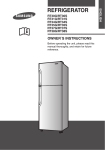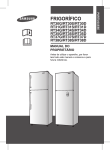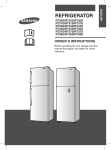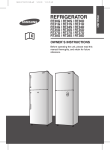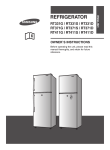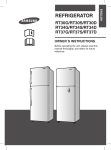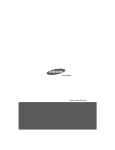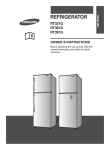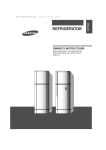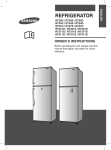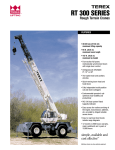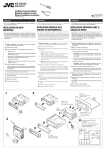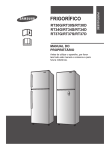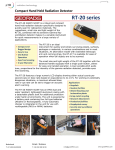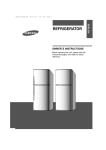Download Samsung RT34SSIS User Manual
Transcript
RT30G/RT30S RT31G/RT31S RT34G/RT34S RT35G/RT35S RT37G/RT37S RT38G/RT38S OWNER`S INSTRUCTIONS Before operating the unit, please read this manual thoroughly, and retain for future reference. ENGLISH REFRIGERATOR FEATURES Large freezer storage area - Stores large quantities of food in the freezer. Jumbo storage guard - Holds large bottles securely. Adjustable storage guards - Position them for your convenience and according to the height of your food containers. Mr. Cool pack (option*) - Keep the stored items cool for more time after power cut off. Safety pocket (option*) - Store safely due to the locking system that makes children not open it easily. Silver Nano Deodorizer (option*) - Powerful deodorizer through catalyst and filter. UV LED/PHOTOSYNTHESIS LED (option*) - Using the LED system, the contents in chilled room and vegetable bin have increased Chlorophyll and vitamin contents. Also this system makes contents in container more fresh. Foldable shelf (option*) - Increase the storaged area by folding the foldable shelf when you need to store large-sized items. Remark : * There is not some option according to the model and country. 1 SAFETY INSTRUCTIONS Ensure that none of the pipes on the back of the appliances are damaged prior to disposal. The pipes shall be broke in the open space. Do not plug several appliances into the same multiple power board. Damage to the cord may cause a short-circuit, fire and/or electric shock 4 SAFETY INSTRUCTIONS If you experience difficulty when changing the light, contact your service center. 5 SAFETY INSTRUCTIONS REMARK This refrigerator use CycloPentance as insulation blowing gas. Contains fluorinated greenhouse gases covered by the Kyoto Protocol. Hermetically sealed system. Do not vent gases into the atmosphere. Refrigerant type : R-134a Quantity : 0.16 kg Global Warming Potential (GWP) = 1300 CAUTIONS WHILE USING Do not place carbonated or fizzy drinks in the freezer compartment. This product is intended only for the storage of food in a domestic environment. • Manufacturer's recommended storage times should be adhered to. Refer to relevant instructions. • Please observe maximum storage times and expiry dates of frozen goods. • The appliance might not operate consistently (possibility of defrosting of contens or temperature becoming too warm in the frozen food compartment) when sited for an extended period of time below the cold end of the range of temperatures for which the refrigerating appliance is designed. • Do not store food which goes bad easily at low temperature, such as bananas. • Your appliance is frost free, which means there is no need to manually defrost your appliance, as this will be carried out automatically. • Temperature rising during the defrost can comply with ISO requirement, But If you want to prevent an undue rise in the temperature of the frozen food while defrosting the appliance, please wrap the frozen food in several layers of newspaper. NOTE Any increase in temperature of frozen food during defrosting can shorten its storage life. 6 CAUTIONS WHILE USING - Do not allow water to splash onto the back of the refrigerator. - Water impairs the insulation of electric parts and may cause an electrical short or a shock hazard. - Do not use flammable sprays such as lacquer and paint near the refrig. erator - Heat from the refrigeration unit may ignite flammable aerosols. - Do not allow unattended children to play in or around refrigerators and other large appliances, The child may get hurt or they could damage the appliance. - To avoid damage to the refrigerator or injury to the child, do not allow children to hang on the refrigerator door. - For optimum operation, do not leave the door open for any longer than necessary. - Leaving the door open allows warmer air to enter the refrigerator and causes the refrigeration unit to use more energy to maintain the cool temperature. - Do not store volatile chemicals such as ether and benzene in the refrigerator. - The fumes, besides damaging food, can build up and cause an explosion. - Do not use the refrigerator if it is not operating correctly or has been damaged. Disconnect it from the power supply and call your local service center. - If the power cord is damaged, avoid a hazard by replacing it through the manufacturer or its service agent or a similarly qualified person. 7 INSTALLATION Install this refrigerator on a firm, flat surface. For optimum operation, normal room temperature is recommended. Avoid locations affected by draughts or dampness. For optimum operation, normal room temperature is recommended. Avoid locations in direct sunlight, near heaters, rediators, stoves or ovens. Allow a 50mm space between the refrigerator and the wall. If your refrigerator is going into a recessed area, allow at least 300mm clearance above the refrigerator. For personal safety, properly ground this appliance. Do not ground this refrigerator with a telephone line, gas pipe, etc. 8 above 300mm above 50mm above 50mm LEVELING THE APPLIANCE To compensate for any floor unevenness, adjust the height of the appliance by turning the adjustable feet clockwise or counterclockwise. The adjustable feet are at the front along the lower edge of the refrigerator chassis, When the refrigerator leans to the left, turn the left front foot counterclockwise. When the refrigerator leans to the right, turn the right front foot counterclockwise. BASIC PREPARATION Before using Wipe the appliance inside and outside using a cloth dampened with warm water and a small amount of detergent. Before plugging in for the first time, allow the refrigerator to stabilize for at least one hour. Allow the freezer compartment to cool for 2 to 3 hours before storing food. - Keep ventilation opening in the appliance enclosure or mounting structure clear of obstruction. - Do not use mechanical devices or any other means to accelerate the defrosting process, other than those recommended by the manufacturer. - D0 not damage the refrigerant circuit. - Do not place or use electrical appliance inside the refrigerator/freezer, unless they are of a type recommended by the manufacturer. - When disposing the refrigerators; should be followed the disposal law of your country. 9 Making ice cubes Tray Type(option) Fill the tray ice with water taking care not to overfill. Water level Hold both ends of the ice tray, remove the ice cubes from the tray by twisting it gently. Twist Type(option) Fill the ice cube tray with taking care not to overfill. Water level Slide the tray onto the cube shelf. Removing Ice cubes - Place the ice tray at the originally provided position by manufacturer in the order to achieve optimal ice-freezing. - To get more space, you can remove the Ice tray and ice storage bin since it does not affect thermal and characteristics. A declared storage volume of frozen food storage compartment is calculated with these Ice tray and ice storage bin removed. 14 Remove the ice cubes from the ice cube tray by twisting the ice tray levers. Make sure the ice storage bin is beneath the ice cube tray (see diagram below) Knobs of ice tray Chiller Compartment - Pull the chiller compartment towards you until it meets the stopper. - Tilt the front upward and continue pulling the compartment out. Adjustable Storage Guard Lift straight upwards to release the tabs, then pull it out of the refrigerator. (These storage guards are adjustable and may be positioned to best fit your needs.) Bottle Storage Guards Lift straight upwards to release the tabs, then pull it out of the refrigerator.(This bottle storage guard is not adjustable; it fits in only one position.) Safety pocket Lift straight upwards to release the tabs, then pull if out of the refrigerator.(This compartment is only used in this position) * option of some model 18 BEFORE CALLING SERVICE when the Refrigerator / Freezer is not operating or the food does not freeze suffciently: - Is the plug properly connected? - Is the power fuse blown? - Are the temperature controls set properly (not set to “COLD”)? - Is the appliance exposed to direct sunlight or installed near a heater? - Does the appliance have enough clearance from the wall in all directions? when you hear a sound like water flowing: - This sound is generated by movement of the refrigerant and is not a malfunction. When food freezes in the refrigerator: - Are the temperature controls set properly (not set to “COLDER”)? - If the food is juicy or very moist, is the tem perature control set to “COLDER”)? - Is the ambient temperature too low? When you notice a foul odor inside the appliance: - Do you have spoiled food in the refrigerator? - Is all food stored in sealed containers? - Has fluid collected in the bot tom of the vegetable bin? - Are the freezer evaporation slots clogged? - Has the evaporation tray at the back of the appliance become foul? When there is noise from the unit: - Is the refrigerator installed on a flat, stable surface? - Is the appliance positioned too close to a wall? - Are there any objects behind or under the refrigerator? - Is the sound coming from the compressor? When frost develops inside the freezer: - Does the door seal tightly? - Are the evaporation slots clogged? - Is there enough room for effi cient air circu lation? When the rear or side panel of the refrigerator is hot: - Is a radiation (air ventilator/cooler) pipe installed? - Is the ambient temperature high? - How dew formed on the out side of the appliance because of high humidity? When dow develops on the vegetable compartment: - Does the door seal tightly? - Have you left the door open for a long time? - Is liquid stored without a cover? 20
























